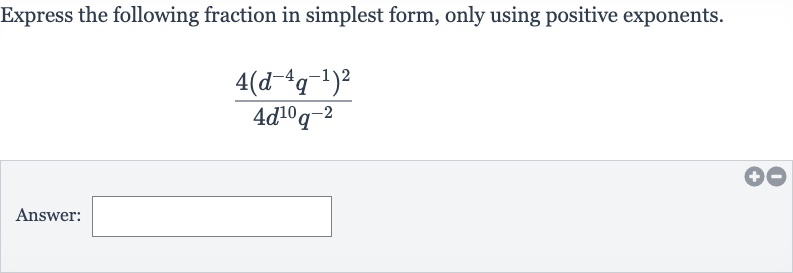AI tutor
Welcome to Bytelearn!
Let’s check out your problem:

Express the following fraction in simplest form, only using positive exponents.Answer:
Full solution
Q. Express the following fraction in simplest form, only using positive exponents.Answer:
- Write & Identify: Write down the given expression and identify the negative exponents.The given expression is .We need to simplify this expression and express it with only positive exponents.
- Apply Power Rule: Apply the power to a product rule to the numerator.According to the power to a product rule, .So, becomes .
- Simplify Numerator: Simplify the numerator using the power of a power rule.According to the power of a power rule, .So, becomes .
- Rewrite with Pos Exponents: Rewrite the expression with positive exponents.To convert negative exponents to positive, we use the rule .So, becomes and becomes .The numerator is now .
- Simplify Denominator: Simplify the denominator.The denominator is .We already know that is , so the denominator becomes .
- Combine Numerator & Denominator: Combine the numerator and denominator.Now we have .We can simplify this by multiplying by the reciprocal of the denominator.
- Multiply by Reciprocal: Multiply by the reciprocal of the denominator.Multiplying by the reciprocal, we get .
- Cancel Common Factors: Cancel out common factors. The terms cancel out, and we can simplify to . Now we have .
- Combine D Terms: Combine the d terms using the rule . So, becomes which simplifies to .
More problems from Multiplication with rational exponents
QuestionGet tutor help
QuestionGet tutor help
QuestionGet tutor help
QuestionGet tutor help
QuestionGet tutor help
